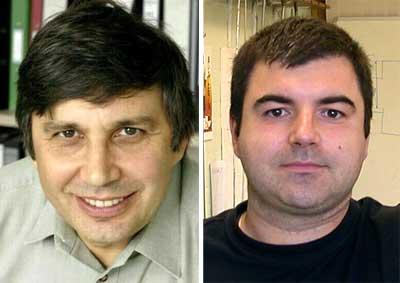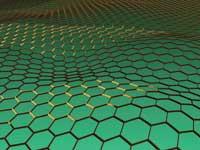Nobel Prize in Physics for Graphene Research

Andre Geim, left, and Konstantin Novoselov.
(Photos: Sergeom, Wikimedia Commons and University of Manchester)
Graphene is a well-known name in the world of scientific dissemination. It is a surprising and, to some extent, new material. Information on the admirable properties of graphene and the scientific and technological advances based on these properties are constantly being published. At the moment, some are theoretical ideas, others are laboratory prototypes. But experts agree that graphene is very close to being used in practice. This year's Nobel Prize will be awarded to those who first isolated graphene, physicists Andre Geim and Constantin Novoselov from the University of Manchester.
A piece of graphite
It is a new and old material, as it is only a part of the atomic structure of graphite. Graphite, on an atomic scale, consists of numerous plates. And graphene is the material obtained by isolating one of these sheets. It is said to be two-dimensional because it is the only foil of a single atom of thickness. Of course, it is a three-dimensional object, but the properties are the properties of a surface, of a single plate.
The electrons of the atoms that form this single sheet move freely through it. Therefore, graphene conducts electricity as well as metals. In addition, it drives better than metals. On the other hand, being a monoatom foil, it is almost transparent, and a material very resistant at the same time, the chemical bonds that bind the atoms are very robust and stable. Experts also highlight that the Hall effect is easily visible, that is, when the graphene foil is crossed by a magnetic field, it creates an electric field in the material. This useful property also appears in many other materials but at very low temperatures. Graphene appears at room temperature. In short, it is a wonderful material.
But graphene has a problem: it is not easy to isolate. Although the graphite sheets do not bind very strongly together, isolating one is very complex. And that material that in theory seems wonderful could not be created.

Method of zeal
Until 2004. That same year, Andre Geim and Constantin Novoselov used the zeal method to exfoliate graphite, that is, isolate the unique graphene plates. By rubbing the graphite on a piece of silicon they obtained pieces of hundreds of sheets. They were hit with a material similar to zeal on both sides, and when the heat opened they got pieces with less sheets. Geim and Novoselov repeatedly repeated this process until they isolated the unique plates.
The method was not new, but no one was able to isolate graphene. The two awarded scientists did, and after confirming that the plates were of a single atom, obtained electrodes that measured the conductivity of graphene and the Hall effect.
This work had a great impact; the scientific community hoped to obtain graphene, which three years later was a 'fashionable' material.
Russians in England
Andre Geim and Konstantin Novoselov were born in Russia, where they studied physics. Then they worked together in the Netherlands, where Geim was the director of Novoselov's thesis and, when he moved to England, he was also. The work of graphene was carried out at the University of Manchester. Andre Geim became famous for winning in 2000 the Ig Nobel in Physics alongside physicist Michael Berry. He is the first person to win the Nobel and the Ig Nobel.
Buletina
Bidali zure helbide elektronikoa eta jaso asteroko buletina zure sarrera-ontzian











